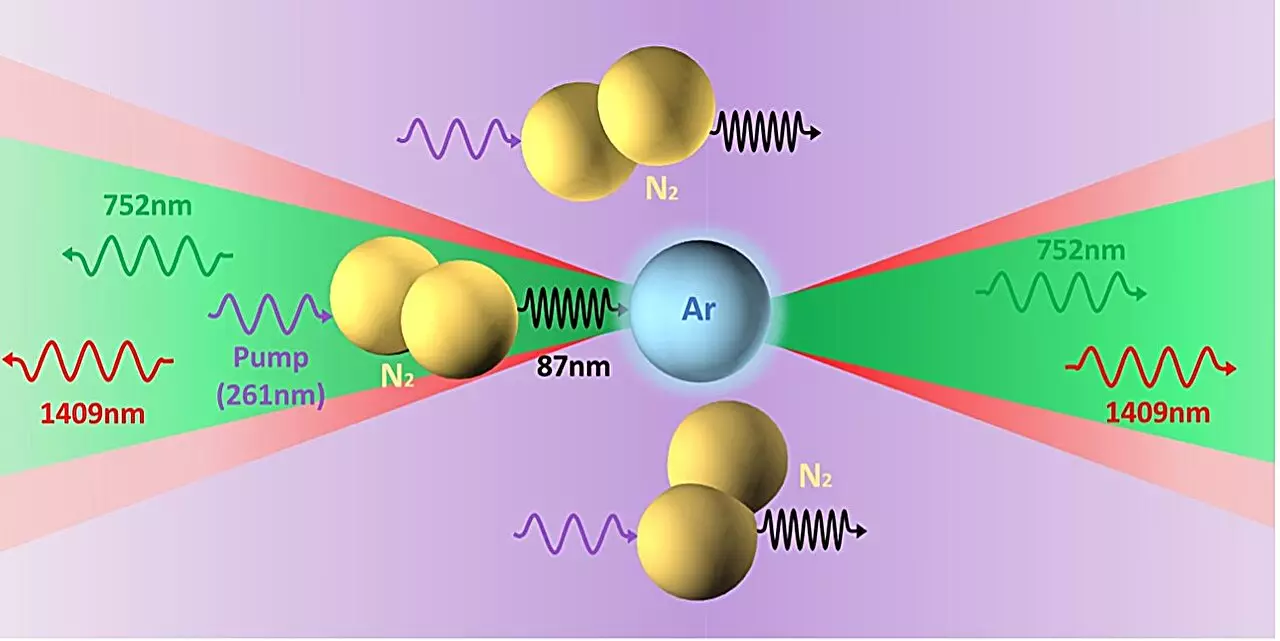The world of lasers has long revolved around the principle of optical cavities, where pairs of reflective surfaces serve to amplify light through a relentless cycle of bouncing photons. However, physicists are now venturing into uncharted territory with the ambitious pursuit of cavity-free lasing, particularly in atmospheric air. A recent collaborative effort by researchers from UCLA and the Max Born Institute has unveiled a groundbreaking mechanism that facilitates this phenomenon, heralding a new era in laser technology.
The study, recently published in Physical Review Letters, centers on a previously unrecognized method of energy transfer between nitrogen (N2) and argon (Ar) molecules. According to Chan Joshi, a co-author of the research, an unexpected reduction in the ionization rates of argon in high-field conditions was observed. This discrepancy prompted investigators to consider the role of a three-photon resonant absorption process involving 261 nm photons in argon, laying the groundwork for their explorations into the emission of laser-like light.
The team’s research builds on previous experiments, revealing that three-photon absorption triggers a phenomenon known as cascaded superfluorescence. This newly identified type of emission is characterized by being bidirectional and devoid of the traditional cavity structure typically associated with laser technology. Lead author Zan Nie further elucidates that the color of the emitted light can be altered by introducing argon into atmospheric air, leading to the discovery of a novel air lasing mechanism.
One of the critical findings of the research team was the necessity of mixing nitrogen with argon to unlock this air lasing phenomenon. Mixing argon with other gases like oxygen or helium did not yield the same results. Joshi explains, “The results indicated that the coupling between nitrogen and argon is essential for the emergence of this unique lasing process.” This insight sheds light on the importance of specific gas combinations and their roles in energy transfer dynamics.
As N2 molecules transition into excited electronic states, they exhibit nonlinear absorption properties. These shifts in frequency, compared to argon, create an environment conducive to cascaded superfluorescence. As the researchers propose a theoretical model to explain these observations, it becomes evident that this groundbreaking work is both a culmination and a new beginning in the field of laser physics.
A striking aspect of this research is its focus on achieving bidirectional lasing capabilities. The quest to create a two-way communication system for lasers in open air—where emitted light could effectively return to its source—represents a significant leap forward. Co-author Misha Ivanov emphasizes the immense potential applications of such technology, particularly within remote sensing fields. This development is not just theoretically fascinating; it stands to transform practical applications in various scientific and industrial arenas.
The researchers’ findings indicate that with further exploration and understanding of this photon-mediated energy transfer mechanism, numerous applications could emerge. From advanced communication systems to novel sensing technologies, the possibilities are expansive. This innovative approach could also pave the way for laser interactions that are more efficient, simpler, and ultimately, less dependent on bulky optical equipment.
Looking ahead, the team intends to delve deeper into the complex physics surrounding this cavity-free lasing mechanism. Through investigations into quantum beating and the coupled dynamics of gases, such as the vibrational-rotational levels of nitrogen, researchers aim to refine their understanding of the intricate interactions at play. Nie notes, “Our aim is to uncover the finer details of these oscillations and their implications for this innovative lasing technique.”
The researchers’ future work could illuminate previously unexplored aspects of atomic and molecular interactions, contributing to a broader understanding of laser dynamics. As the study of cavity-free lasers evolves, it exemplifies the profound interconnectedness of various scientific fields, showcasing how breakthroughs in one area can ignite advancements in others.
The recent investigations into cavity-free lasing in atmospheric air signify not just a scientific breakthrough, but a transformative shift in how we understand and utilize laser technology. By revealing a unique energy transfer mechanism between nitrogen and argon, researchers have opened new doors for practical applications that harness the power of light in ways previously thought impossible. With continued research, the future promises exciting advancements that could redefine our approach to remote sensing, communication, and beyond. As we stand on the precipice of these innovations, the anticipation for what lies ahead is palpable within the scientific community.

